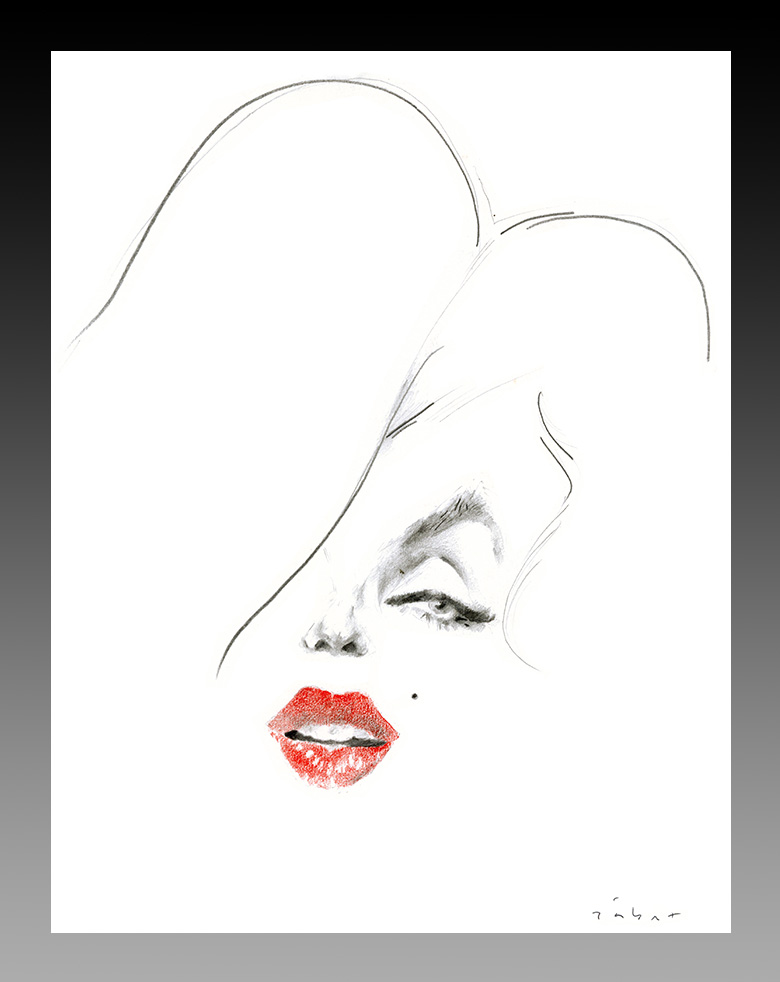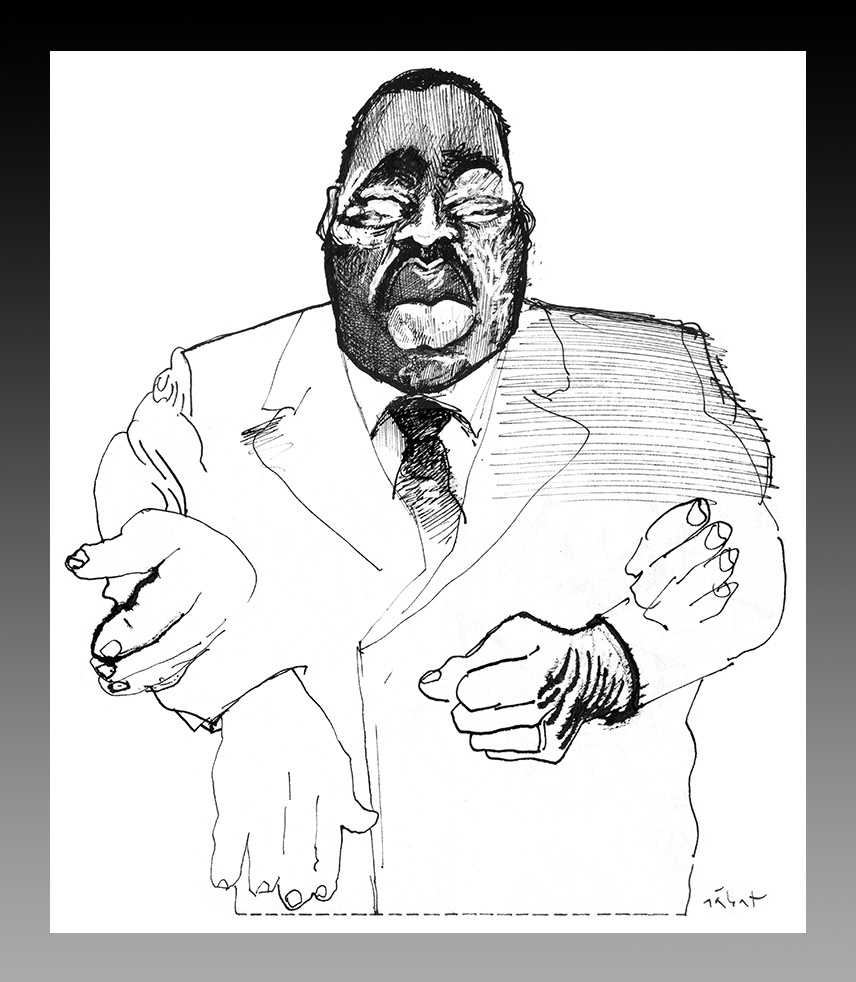Unmatched. Multi-disciplinary. Masterfully unique. The National Museum of Decorative Art (Buenos Aires, Argentina) inaugurated on April 4 the surprising exhibition dedicated to the multifaceted and expressive universe of Hermenegildo Mariano "Menchi" Sábat Garibaldi (1933, Montevideo – 2018, Buenos Aires), an artist whose genius transcends temporal and geographical boundaries. Sábat, master of masters, surprises us with his extensive gallery of famous and essential portraits, representing artists, thinkers, everyday figures and historical figures, all captured with an inspiring charge of infinite genius and humanity that invites us to learn, inspire and move.
Hermenegildo Sábat: Master of Portraiture, curated by Hugo Pontoriero and who writes to you, presents nearly two hundred original works of the portrait genre, including some unpublished pieces, by the best portrait painter in this American region and possibly in the world (I playfully invite the reader to reflect and make the necessary comparisons) of the 20th century. With great technical skill and plastic mastery, Sábat delights us with countless extraordinary portraits, highlighted by their physiognomy details and harmonious sensitivity, made in various dry and wet materials on canvas and paper. This exhibition is a well-deserved tribute to a giant of Latin American art, while revealing unprecedented aspects of his life and work, showing for the first time the multiple artistic skills that he masterfully knew how to master.
The genesis of this recovery begins in 2020; With the help of the artist and son of the master, Alfredo Sábat, we began to organize and value his father's legacy, a legacy similar to that of several of our most excellent exponents of the arts, who navigate hanging between the reconquest or the abyss of oblivion, lacking prior planning for the future of their work, either due to the irremediable denial of the inevitable or a product of the natural creative chaos of artists, and also due to the lack of interest, curiosity and planning on the part of entities public and private of our heritage collection. How necessary is the rescue, conservation and dissemination of the masters of yesteryear and their works! How close many will be to the tide of amnesia and ingratitude because of those of us who should honor their works.
At this point, the work of each and every one of us is essential, promoting the rescue of our greatest representatives, protecting them, and making them known to the world, with certain views towards the future. For this reason, and for our literal “love of art”, always in force, a pure and undoubtedly romantic concept that Eugène Delacroix left in a letter back in 1829, and with the commitment to share stories and thoughts, transmit emotions and preserve culture and art, is that we embark, from the private sphere, from the intimate of the private, in this colossal adventure of four years of intense work, emotion and dedication.
In 2022, together with the also extraordinary artist Jorman Gutiérrez, “poet painter”, as his teacher and friend Guillermo Roux baptized him, we got to work and held an exhibition at ZINK Salon Privé, where we presented 65 works by Sábat, prefaced by Mr. Julio María Sanguinetti, twice president of Uruguay. At that moment we knew that we still had numerous tides to navigate and gaps to recompose—like his time in the United States as a photojournalist in the 1950s, rubbing shoulders with artists like Gloria Vanderbilt and Al Hirschfeld, on which we are working non-stop— and that was how we directed our journey to the National Museum of Decorative Art, which, with the help of Hugo Pontoriero, generously opens its doors to us to present part of its essential collection to the general public for the first time since 1997, the year of the last exhibition in a national museum (that time in the Fine Arts Museum of this same city, a selection that was later shared in Uruguay and Brazil), highlighting the varied craftsmanship of the master of the portrait, through which one can enjoy the certainty of each intuitive stain and firm stroke of inks, gouaches, watercolors, charcoals, pencils, acrylics, oils and even pure organic materials such as coffee, in a visual catalog of diverse techniques and varied solutions. The exhibition is a tribute to artists in general, and especially to the unmistakable master, where each work breathes life and humanity. The rhythmic arrangement of the works, together with the unique acoustic atmosphere generated by the repetition and pulsation of its unrepeatable and identifiable strokes, offers the visitor a surprising and educational experience, amplifying the emotional resonance of Sábat's work.
This selection also allows us to know his different plastic, visual and artistic expressions. Sábat, being essentially free, is not limited to the art of portraiture, but also masterfully dabbles in painting, illustration, graphic journalism, editing, photography, music, sculpture and even poetry. His legacy is immense and goes beyond the artistic, encompassing the historical, the social and especially the cultural, with many trying to replicate the style of the genius, which Mario O'Donnell baptized as Sabbathism. This mimesis is more than simple admiration for a talented artist: it is recognition of his enduring impact on the art and culture of humanity.
Sábat, a curious self-taught person, was a very dedicated student of biographies, organized in endless rows of carefully cataloged books, a visible result in the capture of the spirit of his characters, reflected in masterful works such as that of the rogue and accomplice Gabriel García Márquez; in the versatility of techniques and materials stamped in the imprint of the masterful Delacroix; in the simple blue of the radiantly friendly Louis Armstrong; in the genius of Martin Luther King's synthesis and the graphics with which, with just a few curves, he manages to move us to tears as we recognize them as those hugs that changed the world; in Debussy and Dvorak, portrayed in magnificent watercolors where the master captures his control of the elements, especially water and pigments made matter and rhythmically organized almost by chance; in all the works in his collections published in Jazz a la Carte and SCAT! (some of the almost thirty books that the master knew how to organize and illustrate with absolute mastery of color, line and stain); in her almost unpublished works on canvas such as La Banda (1980) and El Día Que Nació Marta (1966), where she portrays her as presciently extraordinary emerging from the mind of Jorge Romero Brest; and in the immaculate and ethereal Marilyn Monroe, simplified with a few very few strokes, which make us doubt if it was real, or just a dream.
Hermenegildo Sábat, The Band, oil on canvas. 1980.
Sábat was a precursor in telling History in real time—so in line with current instantaneity—not as a picture of the past, but as a poetic thread that, rhythmically and to the sound of society, simply happens, just as the atmosphere flows. acoustics of those staves that touched his spirit so deeply. “In ten strokes, Menchi is capable of drawing the world,” Pablo Calvo, journalist, friend and writing partner, wrote back in 2017.
Recalling his life, some more quotes stand out, many by people as great as they are unforgettable, from Fontanarrosa, Robert Cox and María Elena Walsh, as well as those from his own words, such as when in 1996 he responded in a way that was as accurate as it was intuitive to a asks about the influence of technology on art: “I notice that there are machines that solve things faster. Yes. But I also see that this is like a merry-go-round: you always go on the same side.” How right he was, and how applicable this quote is also to the gallery of those portrayed in his journalistic work, repeated protagonists of the almost 50 years of Argentine history illustrated by his genius—and always without words—in the editorial staff of Diario Clarín, until the last of his days. His keen sense of observation is reflected in this everyday and ephemeral news paper, acclaimed for its intelligent humor and social criticism. Just like the unmistakable French and British illustration artists of the 18th and 19th centuries, such as Tenniel and Daumier, Sábat knew how to express his vision of the world through the most fleeting and accurate tones of each sitter, always maintaining the wonderful authenticity of his style. Likewise, Sábat continued the saga of illustrative artists in Argentina of the previous generation: Alejandro Sirio, Gregorio López Naguil, Jorge Larco and Juan Ballester Peña, among others. According to María Elena Walsh: "Sábat teaches us to read images. Routine does not petrify him, the precariousness of the impression stimulates him and then he changes his style, confuses his imitators and becomes more unmistakable."
Hermenegildo Sábat in his workspace, the editorial office of the newspaper Clarín, in Buenos Aires.
In addition to his outstanding career in journalism and illustration, Sábat was honored with the title of Emeritus Personality of Argentine Culture in 1996 and years later served as president of the National Academy of Journalism. He was awarded in New York with the María Moors Cabot Award (Journalism, Columbia University, 1988) and the Pedro Figari National Prize for Painting (Montevideo, 1997), among others. Due to his impeccable conduct in the face of power, in 2011 he was recognized with the TRIBUTE Award from the New Ibero-American Journalism Foundation, led by Gabriel García Márquez. In 2012 he is part of the Honorary Board of Directors of the Museum of Humor, accompanied by Quino, Manuel García Ferrer, Guillermo Mordillo and Carlos Garaycochea, to which Carlos Nine and Fernando Sendra are added, and directed by Hugo Maradei. And it is in 2017 when he receives the Konex Award for Brilliant Communication-Journalism.
His legacy goes beyond his artistic abilities; It is a testament to his commitment to truth and his ability to capture the essence of an era through his art. Just like Gardel to River Plate music and Borges to universal letters, Sábat is the great master of American portraiture.
This selection, in addition to revealing Sábat's artistic skill, adds immense value on a social and art historical level, reflecting the diversity of interpretations, cultural content and inspiration for the public. Hermenegildo Sábat: Master of Portraiture is a well-deserved tribute to one of Latin America's most outstanding talents, whose work continues to inspire generations of artists and viewers, reminding us of the depth and beauty of the human soul.
* April 2024. Special for Hilario. Arts Letters Trades.


